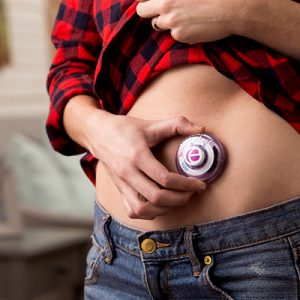
Patient Tolerability with High-Viscosity, Large-Volume Subcutaneous Infusions
The need for something different
Traditional methods of subcutaneous drug delivery include autoinjectors and infusion pumps. These delivery regimens allow for small-volume delivery of low-viscosity drugs, with a high value placed upon minimizing delivery time – getting the drug into the injection site as quickly as possible. Patient experience is becoming more important, as it relates to overall drug efficacy and safety.
The introduction of biotherapeutics, which require higher concentrations of active pharmaceutical ingredient to meet efficacy requirements, has not only challenged the previously established limits of volume, viscosity, and flowrate, but the devices used to deliver them. The trend for subcutaneous administration is moving to large-volume injections of high-viscosity drugs. But there are many questions that are not well understood. What is it like to inject 5, 10, 15 milliliters (mL) and greater volumes of a high-viscosity biotherapeutic into subcutaneous tissue at high flowrates? More importantly, can the patient continue to tolerate this approach?
Many peer-reviewed studies1, 2, 3, 9 have focused on administration volumes of up to 3 mL, flowrates of up to 10 mL per minute, and viscosities of up to 50 centipoise. These studies have been singularly focused on one or two of the abovementioned performance attributes due to limitations with the devices used for delivery. Data is needed on patient tolerability with the combination of large volumes, various flow rates, and higher viscosities associated with subcutaneous infusion.
Devices need to adapt to this new class of drugs. The best design will incorporate a unique set of device attributes and requirements, as well as anticipate key drug and patient variables to produce a safe and efficacious delivery, while maximizing a positive patient experience.
Device Variables and Considerations
Key device design characteristics that may influence patient experience and tolerability during subcutaneous infusion of high-viscosity, large-volume therapeutics include flow rate, skin/needle interface, and needle size. These attributes are discussed further below with respect to patient impact. It is also likely that these variables are interdependent.
Flow Rate
Previous studies3 have focused on high speed injection (autoinjectors) or constant flowrate delivery (infusion pumps) of drugs. The value proposition has been to minimize injection time or allow for a fixed injection time, both of which are preferred. This may be true if the user needs to hold an injection device against their skin or be tethered to an infusion pump. However, infusion time may become less relevant if the user is uninhibited during daily activities while receiving therapy, such as using an on-body delivery device.
At Enable, we believe a slower flowrate (and the associated longer injection time) will be preferred by the patient and improve tolerability of large volumes. It is hypothesized that slower flowrates could lead to a lower incidence of site reactions and injection pain.
Skin / Needle Interface (Tissue Tent)
In general, previous studies6, 7, 9 have investigated subcutaneous injections with the use of syringe and needles or infusion sets utilizing butterfly needles. In either case, the user or provider has the ability to control the depth of the needle by either pinching or stretching the tissue at the injection site prior to needle insertion.
The Enable enFuse® wearable technology includes a tissue tent feature on the bottom of the device to automatically stretch the tissue at the injection site. The tissue tent feature is designed to ensure the needle inserts to the correct depth and that drug is delivered into the appropriate anatomical space.
The tissue tent may also provide a secondary benefit by applying a small amount of pressure at the injection site, which may have several advantages. Injection site pressure could reduce the needle insertion pain by disrupting the tissue at the injection site, similar to a nurse pressing on the injection site prior to needle insertion. It is hypothesized that pressure at the injection site could encourage a deeper deposit of drug into the subcutaneous space, especially in cases of larger volume delivery. It could also potentially prevent leakage and backflow, similar to a nurse applying pressure to the injection site at the completion of delivery.
Needle Size
Previous studies have generally investigated subcutaneous injections/infusions with the use of syringe and needles or infusion sets utilizing butterfly needles. These needles4 range from 31 to 26 gauge, with the majority being larger needle size. Other publications have theorized that smaller gauge needles introduce greater discomfort due to increased fluid velocity at a constant flowrate10, 11. Flowrate in conjunction with needle size could be important.
At Enable, we believe a smaller needle size is preferred based on our experience that smaller needle sizes produce less injection site pain6, 7 and less leakage and backflow.
Drug Variables and Considerations
Drug-contributing characteristics that impact patient tolerability of high-viscosity, large-volume subcutaneous infusion must be considered, which includes delivery volume and viscosity.
Volume and Viscosity
The Enable technology is designed to deliver up to 50 mL of drug product independent of viscosity at a specified subcutaneous site. Studies suggest that injection site pressure is less affected by volume and more dependent on viscosity7, 9. Typically, pharmaceutical companies have had the mindset to pursue high-concentration (high-viscosity) and low-volume formulations based on limitations with previously available delivery systems.
Enable is encouraging pharma and biopharmaceutical companies to take advantage of the high-volume enFuse platform to facilitate drug product formulation development for subcutaneous administration by allowing flexibility in the drug concentration and delivery volume.
Other Drug-Specific Attributes
Other drug-specific variables which affect patient tolerability may include pH, osmolality, excipients, and temperature. Much is known5 about patient tolerability with low-volume subcutaneous injections, but what is the pain tolerance and how is it affected by these drug-specific attributes of the therapeutic?
Patient Variables and Considerations
Injection Pressure and Backpressure
The Enable enFuse® utilizes a constant, relatively low pressure mechanism to deliver the drug to the subcutaneous space. Unlike constant flowrate infusion pumps, the enFuse platform automatically adjusts the flowrate of the drug based on the backpressure being created within the injection site. This is fundamentally different and potentially advantageous to patient preference and tolerability compared to constant flowrate pumps.
Previous studies2, 8 have investigated tissue backpressure as a function of flowrate, viscosity, and delivered volume. However, all of these studies were executed with constant flowrate pumps.
Patient Characteristics<
The abdomen is a popular location for subcutaneous injections, due to its easy access and amount of available space. Additional sites, including the inner thigh and back of the arm, could also be considered for subcutaneous injection, although the suitability of these sites for larger infusion volumes is not established. The impact of other patient demographics, such as Body Mass Index (BMI) and skin integrity/type, on infusion and patient tolerability should also be evaluated.
The Enable enFuse®
The patient experience must be an integral part of the device design process to ensure overall safety and efficacy of a drug-device or biologic-device combination product. The Enable enFuse is intuitively designed to incorporate these device and patient-centric features to ensure dose accuracy and reliability while maximizing a positive patient experience.
Enable Injections is invested to improve the patient experience for large-volume subcutaneous administration of high-viscosity therapeutics with the enFuse platform. To learn more, visit our Technology page or contact us.
Author:
Matt Huddleston, EVP and Chief Technology Officer, Enable Injections
Resources:
- Berteau, C, et al. “Evaluation of the impact of viscosity, injection volume, and injection flow rate on subcutaneous injection tolerance.” Med Devices, 2015 Nov 11;8:473-84. doi: 10.2147/MDER.S91019. eCollection 2015. https://www.ncbi.nlm.nih.gov/pmc/articles/PMC4646585/. Accessed 18FEB2019.
- Zijlstra, E, et al. “Impact of Injection Speed, Volume, and Site on Pain Sensation.” Journal of Diabetes Science and Technology, 2018 Jan; 12(1): 163-168. https://www.ncbi.nlm.nih.gov/pmc/articles/PMC5761988/ Accessed 18FEB2019.
- Praestmark, K, et al. “Injection Technique and Pen Needle Design Affect Leakage from Skin After Subcutaneous Injections.” Journal of Diabetes Science and Technology, 2016 Jun 28; 10(4): 914-22. https://www.ncbi.nlm.nih.gov/pmc/articles/PMC4928216/ Accessed 18FEB2019.
- Juul, K, et al. “Influence of hypodermic needle dimensions on subcutaneous injection delivery–a pig study of injection deposition evaluated by CT scanning, histology, and backflow.” Skin Research and Technology, 2012 NOV; 18(4): 447-55. https://www.ncbi.nlm.nih.gov/pubmed/22233448
- Dias, C, et al. “Tolerability of High-Volume Subcutaneous Injections of a Viscous Placebo Buffer: A Randomized, Crossover Study in Healthy Subjects.” AAPS PharmSciTech, 2015 OCT; 16(5). https://www.ncbi.nlm.nih.gov/pmc/articles/PMC4674646/ Accessed 18FEB2019.
- Doughty, D, et al. “Understanding Subcutaneous Tissue Pressure for Engineering Injection Devices for Large-Volume Protein Delivery.” Journal of Pharmaceutical Science, 2016 JUL; 105(7); https://www.ncbi.nlm.nih.gov/pubmed/27287520 Accessed 18FEB2019.
- Allmendinger, A, et al. “Measuring tissue back-pressure–in vivo injection forces during subcutaneous injection.” Pharmaceutical Research, 2015 JUL; 32(7). https://www.ncbi.nlm.nih.gov/pubmed/25537343. Accessed 18FEB2019.
- Torjman, M, et al. “Evaluation of an investigational wearable injector in healthy human volunteers.” Expert Opinion Drug Delivery, 2017 JAN; 14(1): 7-13. https://www.ncbi.nlm.nih.gov/pubmed/27809609 Accessed 18FEB2019.
- Patte, C, et al. “Effect of infusion rate and indwelling time on tissue resistance pressure in small-volume subcutaneous infusion like in continuous subcutaneous insulin infusion.” Diabetes Technology & Therapeutics, 2013 April; 15(4). https://www.ncbi.nlm.nih.gov/pubmed/23427865 Accessed 18FEB 2019.
- Alam, M, et al. “Effect of Needle Size on Pain Perception in Patients Treated with Botulinum Toxin Type A Injections: A Randomized Clinical Trial.” JAMA Dermatol. 2015 NOV. https://jamanetwork.com/journals/jamadermatology/fullarticle/2436035. Accessed 18FEB2019.
- Pathak, P, et al. “Effect of Needle Gauge on Perception of Pain Intensity among Infants Receiving D.P.T. Vaccination.” Nursing and Midwifery Research Journal, Vol-3, No.4, Oct 2007. https://medind.nic.in/nad/t07/i4/nadt07i4p172.pdf Accessed 18FEB2019.
